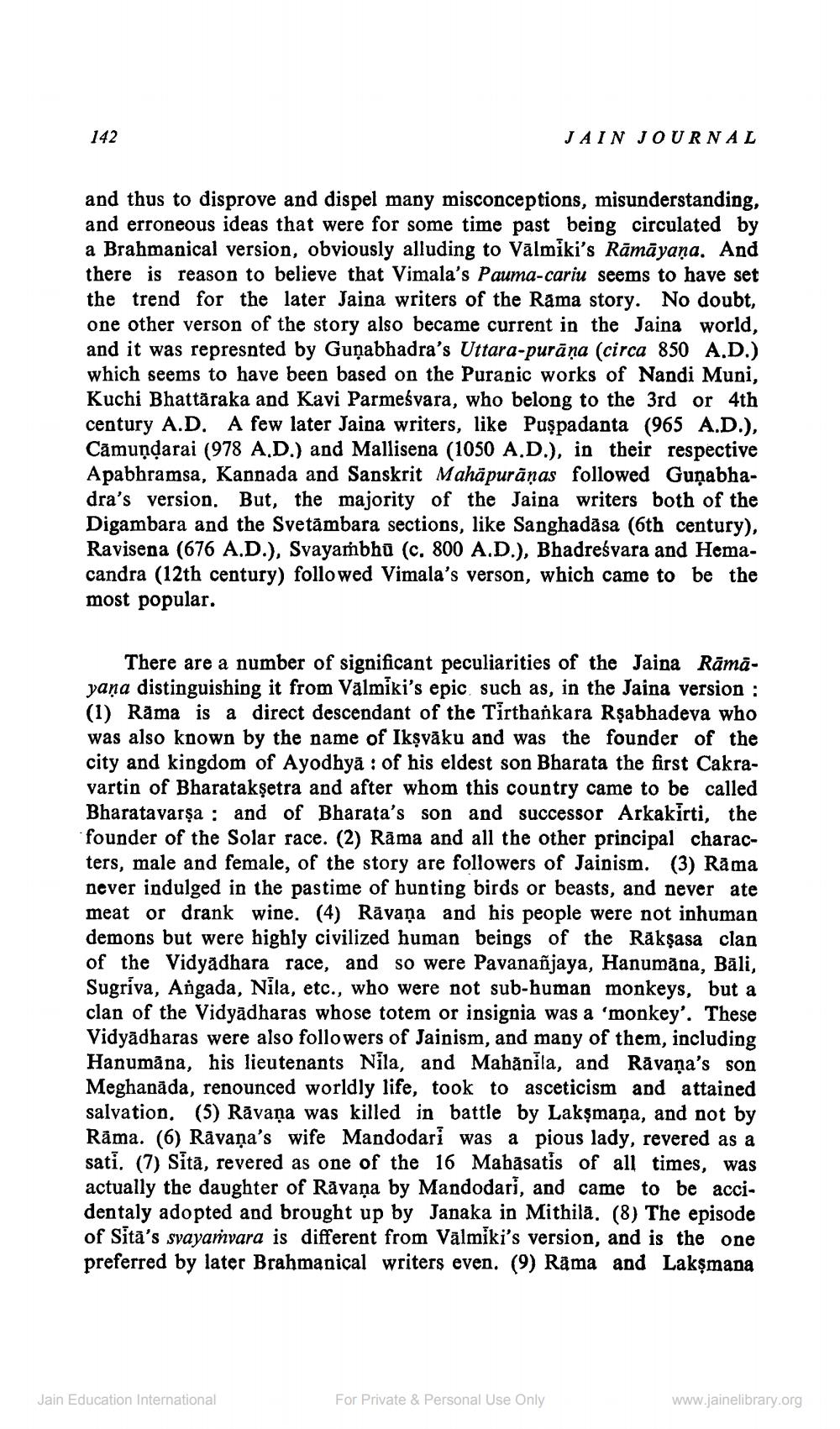Book Title: Jain Journal 1991 10 Author(s): Jain Bhawan Publication Publisher: Jain Bhawan Publication View full book textPage 6
________________ 142 and thus to disprove and dispel many misconceptions, misunderstanding, and erroneous ideas that were for some time past being circulated by a Brahmanical version, obviously alluding to Valmiki's Rāmāyaṇa. And there is reason to believe that Vimala's Pauma-cariu seems to have set the trend for the later Jaina writers of the Rama story. No doubt, one other verson of the story also became current in the Jaina world, and it was represnted by Gunabhadra's Uttara-purāṇa (circa 850 A.D.) which seems to have been based on the Puranic works of Nandi Muni, Kuchi Bhattaraka and Kavi Parmeśvara, who belong to the 3rd or 4th century A.D. A few later Jaina writers, like Puspadanta (965 A.D.), Camuṇḍarai (978 A.D.) and Mallisena (1050 A.D.), in their respective Apabhramsa, Kannada and Sanskrit Mahāpurāṇas followed Gunabhadra's version. But, the majority of the Jaina writers both of the Digambara and the Svetambara sections, like Sanghadāsa (6th century), Ravisena (676 A.D.), Svayambhu (c. 800 A.D.), Bhadreśvara and Hemacandra (12th century) followed Vimala's verson, which came to be the most popular. JAIN JOURNAL : There are a number of significant peculiarities of the Jaina Rāmāyana distinguishing it from Valmiki's epic such as, in the Jaina version : (1) Rāma is a direct descendant of the Tirthankara Rṣabhadeva who was also known by the name of Ikṣvāku and was the founder of the city and kingdom of Ayodhya : of his eldest son Bharata the first Cakravartin of Bharatakşetra and after whom this country came to be called Bharatavarṣa and of Bharata's son and successor Arkakirti, the founder of the Solar race. (2) Rama and all the other principal characters, male and female, of the story are followers of Jainism. (3) Rama never indulged in the pastime of hunting birds or beasts, and never ate meat or drank wine. (4) Rāvana and his people were not inhuman demons but were highly civilized human beings of the Raksasa clan of the Vidyadhara race, and so were Pavanañjaya, Hanumana, Bāli, Sugriva, Angada, Nila, etc., who were not sub-human monkeys, but a clan of the Vidyadharas whose totem or insignia was a 'monkey'. These Vidyadharas were also followers of Jainism, and many of them, including Hanumana, his lieutenants Nila, and Mahanila, and Ravana's son Meghanāda, renounced worldly life, took to asceticism and attained salvation. (5) Ravana was killed in battle by Lakṣmaṇa, and not by Rāma. (6) Rāvana's wife Mandodari was a pious lady, revered as a sati. (7) Sita, revered as one of the 16 Mahāsatis of all times, was actually the daughter of Ravana by Mandodari, and came to be accidentaly adopted and brought up by Janaka in Mithila. (8) The episode of Sita's svayamvara is different from Valmiki's version, and is the one preferred by later Brahmanical writers even. (9) Rama and Lakṣmana Jain Education International For Private & Personal Use Only www.jainelibrary.orgPage Navigation
1 ... 4 5 6 7 8 9 10 11 12 13 14 15 16 17 18 19 20 21 22 23 24 25 26 27 28 29 30 31 32 33 34 35 36 37 38 39 40 41 42 43 44 45 46 47 48 49 50 51 52 53 54 55 56 57 58
